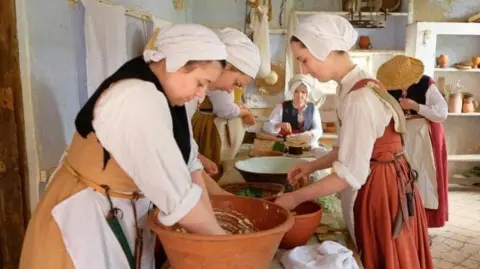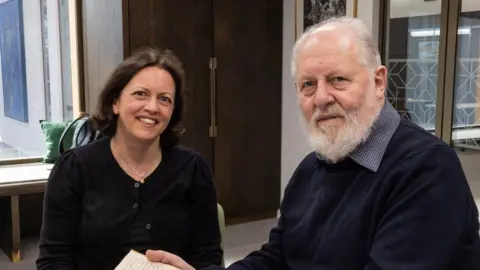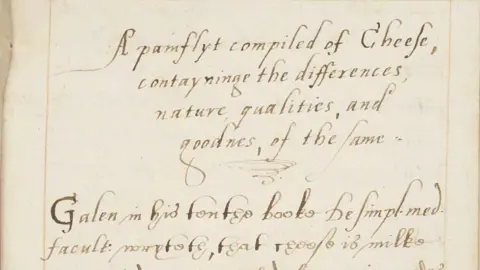Cheeseboard origins discovered in Tudor manuscript
 Getty Images
Getty ImagesThe tradition of having a cheeseboard at the end of a meal dates back at least 400 years to Tudor times, according to historians studying the the oldest English book on cheese.
The origins of the post-meal staple were uncovered in the Elizabethan manuscript during work to transcribe the original handwritten text, held at the University of Leeds, by Tudor re-enactors at Kentwell Hall in Suffolk.
The 16th Century document - titled A pamflyt compiled of Cheese, contayninge the differences, nature, qualities, and goodnes, of the same - had been unknown until it was bought at auction in 2023.
Speaking to Radio 4, Dr Alex Bamji, professor of early modern studies in Leeds, said the text showed some Tudor people had a cheeseboard at the end of a meal, like we do today.
 Mike Hill
Mike Hill"People were really interested at this time about when you should eat cheese," Dr Bamji said.
"Generally the view was that it was best to eat cheese at the end of the meal.
"That's quite interesting because in some cultures in Europe you eat cheese at the end of the meal, and that's persisted through time.
"It is the origins of the cheeseboard. They would have a selection of cheese at the end of the meal, much as we do today."
 University of Leeds
University of LeedsThe transcription was made by Ruth Bramley, who used the digitised version of the 112-page manuscript, which dates back to the 1580s, on the university's website.
Ms Bramley is a re-enactment expert in textiles, but also has experience transcribing early modern handwriting, she said.
Her colleague Tamsin Bacchus, who works in the Tudor dairy at Kentwell, said the author's comments on Suffolk cheeses were "scathing".
"It's reassuring to find written down what we know from our actual practice in the Kentwell Dairy: that to make a really hard cheese to keep indefinitely ('Suffolk Thump') you skim off all the cream.
"He's a bit scathing about it, though, calling it 'the worste kind of cheese, accordinge to our Englishe proverbe, hit is badde cheese when the butter is gone to the market'."
 University of Leeds
University of LeedsThe identity of the book's author is unclear, but three owners' names show it circulated around a family of Tudor courtiers called the Dudleys.
Walter Bayley, whose name appears at the end of the text, was physician to Elizabeth I.
Food historian Peter Brears said he had "never seen anything like it".
"It was absolutely astonishing, because it's not the sort of housewifely farm economy volume, it's an incredible work of scholarship in its own right.
"This shows us that we have a cheese heritage and even by the Elizabethan period cheese of different kinds are being considered and here we have a study of the importance of cheese from a dietary point of view."
Listen to highlights from West Yorkshire on BBC Sounds, catch up with the latest episode of Look North.
